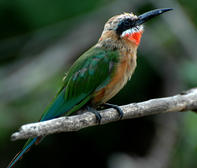
Name
White-fronted Bee-eater (Merops bullockoides)Appearance
This is the only bee-eater in the region with a red/white throat. The white-fronted bee-eater is green on top with buff underparts. The white-fronted bee-eater has a white forehead, a black eye stripe, a bright red throat, with a white line separating the beak and the throat.The White-fronted bee-eater has a square-ended tail. The total length of the bird is around 23 cm.
Diet
The white-fronted bee-eater hunts flying insects on the wing. Once they catch an insect, they will return to a perch, to kill the insect and remove its sting, by repeatedly hitting the insect against the branch.White-fronted Bee-eater Breeding
The white-fronted bee-eater is monogamous and colonial. The pairs mate for life and dig a tunnel in vertical banks. A new nesting tunnel is dug each year. This tunnel can be as deep as 100 cm. They do not line the nest cavity and the 2 to 5 eggs are laid directly on the sand.
The eggs are incubated by both parents and helpers for around 21 days. The chicks fledge at around 28 days. The white-fronted bee-eater is a social breeder and when breeding, other family members will help with building the nest, incubation and feeding of the chicks. This bee-eater is parasitized by the Greater Honeyguide (Indicator indicator).
White-fronted Bee-eater Behaviour
The white-fronted bee-eater is gregarious and is found in small flocks. The flocks often remain in the same area of the breeding territory year round and use the nest holes to roost at night.They often use the same perch repeatedly when hunting, taking short flights to catch their prey then returning to the same perch.